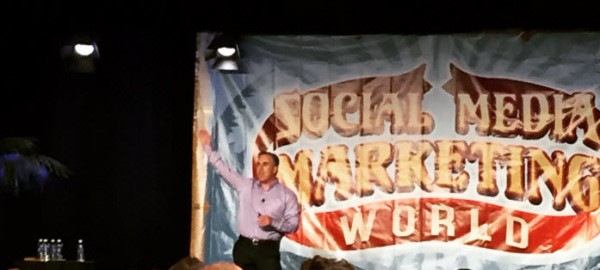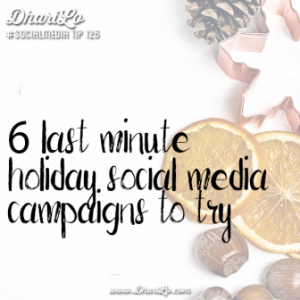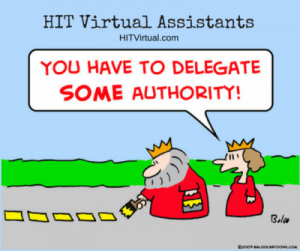One way to keep up with the changes in social media marketing is to follow the experts — read their blogs, follow their social media feeds and subscribe to their newsletters.
You can also attend conferences to see the experts in person, meet others in your industry, and learn about the latest trends and tactics.
I recently joined 2,500 of my marketing peers in San Diego at this year’s Social Media Marketing World conference.
Here are my top takeaways from the event:
1. 2015 is the year of native video
Mike Stelzner, founder of Social Media Examiner and Social Media Marketing World, said that native video, which is video uploaded directly to a social platform instead of posting a link to a video, is driving more engagement.

Mike Stelzner, Founder Social Media Examiner
Native video is getting better results for marketers on Facebook, and there’s been a 360 percent increase in video content posted to the Facebook News Feed.
Recent Facebook changes highlight the importance of video content; you can now feature a video, create video playlists on your page, and add a call to action button. Other social networks are picking up on this trend, including Twitter, which recently introduced 30 second native video uploads to its platform.
2. Visual content is driving engagement
Most social networks are becoming increasingly visual. There are also certain social networks — like Pinterest and Instagram — where you can only post visual content. If you haven’t been focusing on images in your social media marketing, now’s the time to start.
Guy Kawasaki, author and chief evangelist of Canva, recommended using some kind of visual content in every post. It’s doubled his engagement.
If you’re not sure what kind of visual content to create, Donna Moritz of Socially Sorted shared a visual content hierarchy that’s applicable to any small business or nonprofit:
- The first level is shareables: Quotes, tips, and photos are easy to create, and are frequently shared by followers on social media.
- The second level is step by steps: How-tos, checklists, or tutorials that guide your followers and help them solve problems.
- The third level is showpieces: Infographics, slide decks, or short videos that take a little more time to create, but get a lot of engagement from followers.
3. Optimization is key in getting your pins found on Pinterest
Did you know that pins on Pinterest have a long shelf life? Peg Fitzpatrick, author and social media strategist, pointed out that 50 percent of Pinterest visits happen 3.5 months after the content is pinned.

Peg Fitzpatrick, Co-author of The Art of Social Media
That’s because users are going to Pinterest to search for content they’re interested in. In fact, 39 percent of active Pinterest users choose Pinterest over search engines like Google.
Cynthia Sanchez of Oh So Pinteresting said Pinterest has become a discovery tool. “People use Pinterest for themselves; they use it to search and discover things. It’s a search tool with some social functions in it.”
How does Pinterest know what pins to display in a search? Vincent Ng of NCNG Marketing listed 5 factors:
- Pins with a high number of repins and high click through rates will show up higher for search terms and results.
- Pinterest search results are now gender-based, because users have the option to note their gender in their profile.
- Rich pins. Pinterest and Google searches give preferential treatment to pins that are rich pins, which are pins that include extra information from your website. There are 6 types of rich pins — product, article, recipe, place, app and movie — and business pages can apply for them through Pinterest.
- Including two to three keywords in the description of your pins can increase the odds of being found in a search. Use popular but relevant keywords, and find ideas by trying out keywords in Pinterest’s search bar or viewing pins in the most-pinned categories.
- The pin’s URL. Use relevant keywords in the URL that your pin is linked to. Pinterest uses keywords in links to find more information about a pin.
4. Boost your Instagram engagement by posting images and hashtags that are relatable to your followers
You can grow your Instagram engagement and following if you use three best practices: show the people behind your business, share curated photos, and optimize your captions with hashtags.
Peter Stringer, vice president of digital media for the Boston Celtics, said that the images with people get the most engagement on the team’s Instagram account. They share photos of the players during games, but also post images of them behind the scenes interacting with kids at local schools and nonprofits, as well as the day to day activities at the TD Garden arena.
Dan Rosenbaum of San Francisco tourism website Only in SF and Eric Gray of Universal Studios Orlando post original content, but make an effort to share images created by their followers. When you curate, or repost, your fans’ images, you put the spotlight on them, and you’re sharing their view of your business. Just make sure you’re giving credit to the fan who posted the photo by tagging them in the caption or using apps that repost users’ images and tag them in the caption.
The text you use with your Instagram photos is just as important as the photos themselves. Sue Zimmerman, The Instagram Expert, suggested searching for relevant popular hashtags on Instagram or with tools like Iconosquare, and using them in your captions. People like to search for hashtags of the topics they like, and you want your images to show up in that search.
5. Customer service is the new social
Complaints are a part of life when using social media to promote your business. You need to pay attention to them because what you do next with the complaint can cause customers to either leave or become loyal advocates.
Jay Baer, president of Convince & Convert, encourages marketers to “hug your haters” so any issues that are posted publicly don’t escalate and get out of control.
“Haters aren’t the problem. Ignoring them is,” Baer said. “Hating is a spectator sport. The haters will band together if you treat them poorly or if you choose not to address them at all.”
Baer recommends answering all complaints on all social media profiles as soon as possible. 39 percent of social media complainers expect a response within one hour. If there isn’t a response, advocacy decreases by 43 percent. Addressing complaints helps to increase customer advocacy, gives you a chance to turn a bad situation into a good one, and allows you to collect important feedback.
Stay on top social media
Need help keeping up with the changes in social media marketing?
Check out our marketing resources page for blog posts, videos, guides and more for best practices, tips, and advice on the latest marketing trends.
(308)








